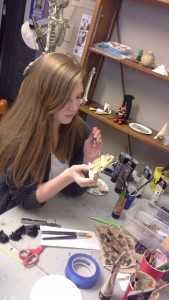There are millions of people around the world who would love close up and personal access to the greatest moments in history. Alas, the world simply doesn’t work like that. If we could grant everybody access to ancient relics, though, we would make serious breakthroughs.
Instead of a select group of archaeologists who simply don’t have enough hours in the day, we could have a massive army of people willing to devote their time and energy to the small tasks that the museums and universities simply cannot tackle.
It will change the face of archaeology as we know it and make history open source. It’s a wonderful prospect.
VCL did not have such lofty goals
The Virtual Curation Library has grown from a small acorn: a Department of Defense project with the Virginia Commonwealth University to document items of historical significance on a local basis. It has now spread around the world and a number of institutions have been in touch.
New York State Museum and Research Laboratory, the University of West Florida, West Carolina University and Garwhal University in India are just a few of the institutions involved.
That has led to collaboration between universities and smaller museums that simply don’t have the resources to work together.
Analytical software suddenly became an option
The ability to readily share digital morphological models with researchers anywhere in the world is a potentially powerful tool, especially now there is freely available software for examining the digital artifact or ecofact model from every conceivable perspective.
This is just impossible with static photographs or illustrations. Digital bone models, for instance, can also be accurately measured on screen. This enables detailed comparisons between the digital object and the artifact or ecofact being studied.
The ability to print accurately scaled replicas of artifacts and ecofacts can be particularly important for small research facilities or universities with limited resources or limited space. For example, with a digital zooarchaeological type collection, it will be possible for anyone to assemble accurate animal bone collections without having any actual animal bones.
Plastic replicas aren’t inherently valuable, this is good
Accurately printed plastic replicas do not have the storage or preservation concerns of real skeletal elements and can be readily and inexpensively replaced from the source digital models if they are lost, damaged, or stolen. The plastic replicas can also be printed on-demand to meet specific identification needs.
This will help museums flesh out collections, it will help teachers bring lessons to life and there is just one more step beyond that. It will boost engagement with archaeology through the roof if museums simply open these archives to the public.
We have seen this in other fields. When you give the general public access to the raw data and a platform to discuss it then simple passion and perseverance can lead them to some amazing discoveries.
We are all explorers with Google Earth
Google Earth, for instance, has inspired a legion of armchair explorers located everything from potential alien landing sites through to red lakes in Iraq. For a while, home enthusiasts even thought they had found Atlantis.
Give the whole world access to every single artefact in every museum and the results will be spectacular. Schoolteachers, factory workers and retirees will find ways to compare and contrast different works from around the world. Mathematicians will apply their own algorithms and people from all walks of life will take software and solutions from other fields and apply them to historical data.
Digital access will make life easier
Making archaeological objects accessible to both researchers and the public is an ongoing challenge for museums and collections repositories. In many cases, curators understandably restrict access to artifacts that are too delicate for handling, especially in the absence of dedicated funding for archaeological conservation.
Imagine giving everybody instant access. Now go further, they can overlay important artifacts from opposite ends of the world on a screen and look for similarities.
Historians will be blown out of the water by the general population as the sheer weight of numbers means we have to make breakthroughs. They will come from the most unlikely places and if they are thrown open for discussion then miniscule contributions from a vast number of people will drive archaeology forward.
The secrets of life are right around the corner and it could be a teacher, a policeman or a farmhand that finds them.




